|
BULB LOG 29 19th July 2006
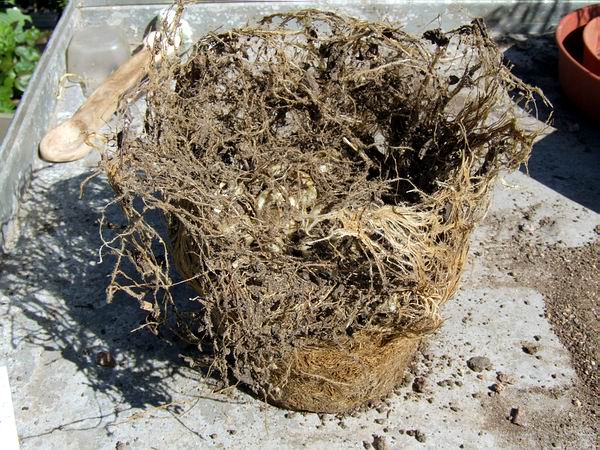
Fritillaria roots
Another and better illustration of how far above the level that the fritillaria bulbs were planted in a pot the roots will come - these have risen several centimetres above the seedling Fritillaria sewerzowii bulbs.
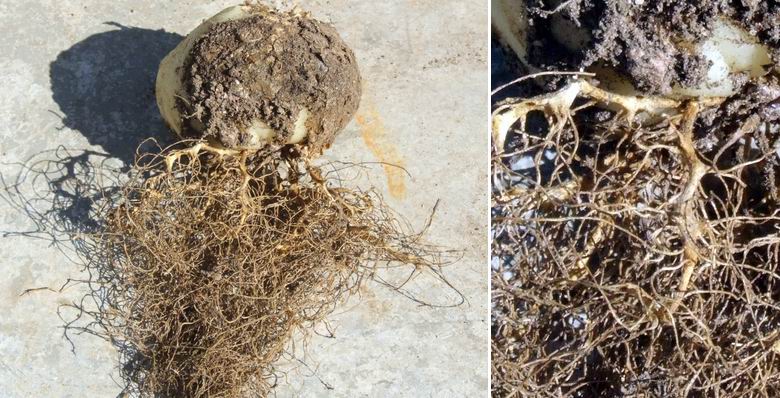
Fritillaria sewerzowii roots
This mature Fritillaria sewerzowii bulb shows clearly the branched root system which distinguishes this species and is one of the reasons given by some botanists to separate into its own genus Korolkovia sewerzowii. However it shares this feature with many of the central Asian Fritillarias, like the imperialis group, and some of the Chinese frits also have branching root systems.
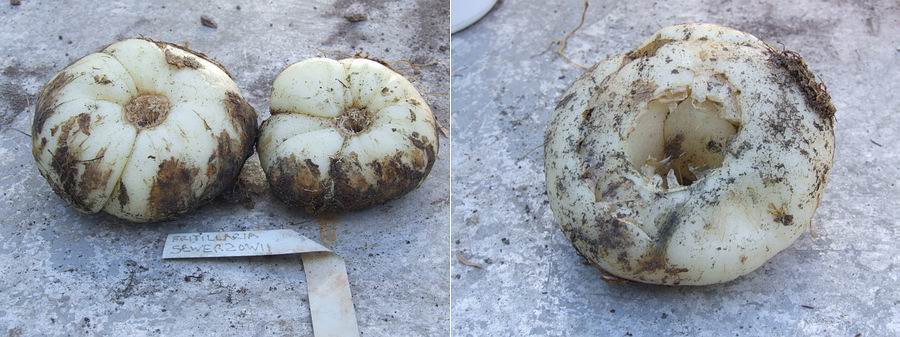
Fritillaria sewerzowii
As regular readers of the bulb log will know, I am fascinated by the form of bulbs; how they grow and how they relate to one another. Unlike the typical twin scaled frit bulb that we see in F. meleagris the bulb of Fritillaria sewerzowii is more of a single unit with no obvious separation of the individual scales. Looking at the base however you can see the ridges that may represent scales which are so tightly packed that they are in fact fused around the central hole where last years flower stem arose. The buds for next year's growth are also down at the base of the central hole, out of view until they elongate next spring to become the flowering stem. Unlike true bulbs such as Narcissus which just get bigger each year, Fritillaria bulbs are completely replaced annually. As the stem grows this entire bulb will slowly shrink away as its resources are either used up or passed on to the new bulb that will form at the base of the flower stem as the flowers fade.
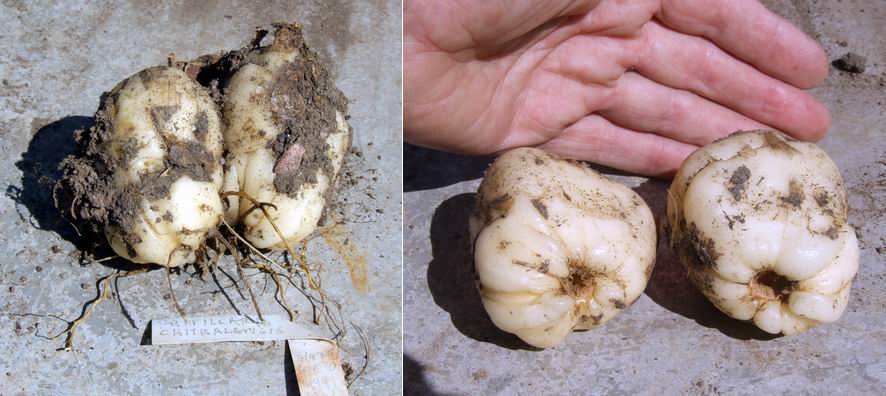
Fritillaria chitralensis bulbs
Fritillaria chitralensis has a very similar bulb structure as well as branched roots. You will remember how pleased I was when my single bulb of Fritillaria chitralensis sent up two flower stems this spring and I speculated that, as a new bulb is formed at the base of each flowering stem I would have two bulbs when I repotted it. Little did I expect that the bulbs would both be as big as their parent had been - I thought I would be lucky to get two smaller bulbs. Boy, am I lucky, as both the bulbs are as big as the single one I had this time last year Can I hope for another doubling up next year or is that tempting fate? Looking at the base of these bulbs you can see the similarity to the F. sewerzowii bulbs above with comparable ridges and a central hole.
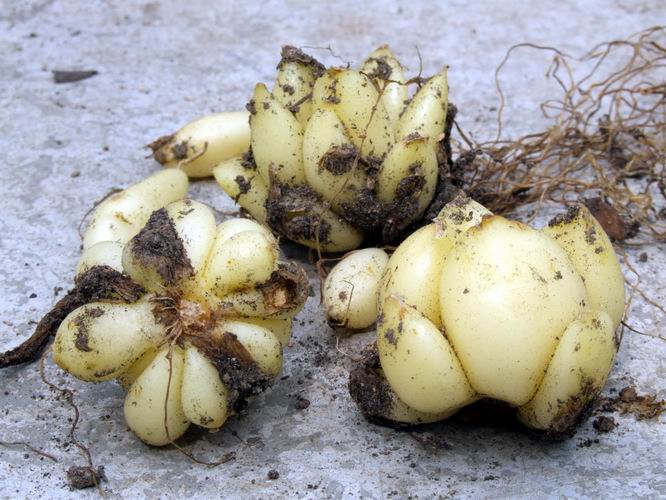
Fritillaria liliacea bulb
Jumping to the North American frits now and looking at the base of some Fritillaria liliacea bulbs, we see how the scales are well developed and separate for most of their length, they are only joined at the base of the bulb displaying those ridges. One big difference with the American fritillaria bulbs is they appear to lack the hole through the centre or it is not so well defined, they also all produce either small, easily detachable, scales or rice grains. These rice grains are formed in the spring attached to the new forming bulb whereas in the 'old world' frits the rice grains form in the autumn on the old bulb just as the bud is just starting to extend. This is a clear difference in growth pattern that must have taken many years of evolution since these two groups evolved from a common ancestor thousands of years ago.

Fritillaria pudica giant form bulb
Last year I was given a bulb of Fritillaria pudica giant form. The flower and leaves looked just like pudica but the bulb looks different from any of the other forms of pudica that I grow. It has a smaller base plate, less rice and the scales form more of a bulb shape than the typical disc I expect from pudica.
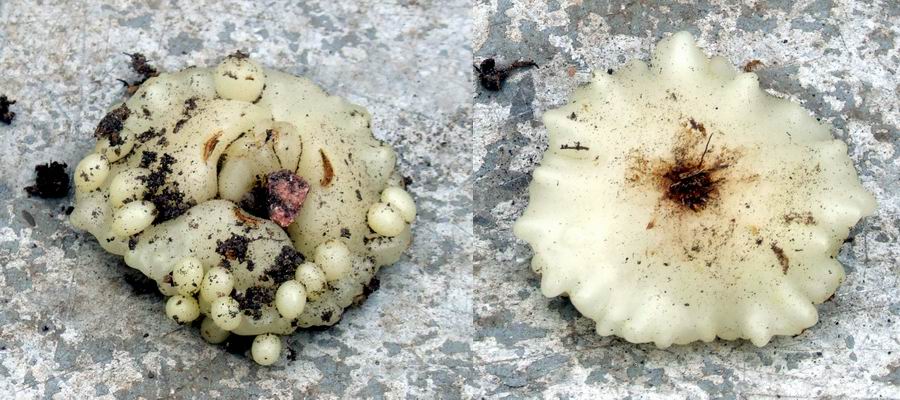
Fritillaria pudica bulb
This is a typical Fritillaria pudica bulb with a flattened disc shape for a base with rudimentary scales rising from it like a cup and saucer. Most of the rice falls off it as soon as you try and move it. Many writers suggest that you do not disturb these bulbs as removing the rice weakens them and prevents them flowering so well.
This is rubbish, the rice is an insurance policy for the bulb so, if the main bulb rots away or gets eaten, its genes will carry on through the masses of rice grains. Losing the rice does not affect the flowering of the bulb. I have written in the past that I believed that animals grazing on these rice grain bulbs must have been part of the evolutionary selection process; the more rice a bulb produces, the greater its chance of survival.
Now I think the main factor, so obvious when you work it out, is environmental and specifically climatic. I have shown previously the rotten remains of some frit bulbs I find when repotting - this rot is a result of too much moisture around the bulbs when they are dormant. Mature rice grain bulbs can easily rot off in poor growing conditions but they nearly always leave some rice to grow on. So, while grazing in the wild could account for some of a population of mature bulbs being wiped out, an unseasonable period of cold and wet weather during the bulbs dormancy could result in all the mature bulbs in a population rotting away leaving only the rice grains to carry forward their genes.
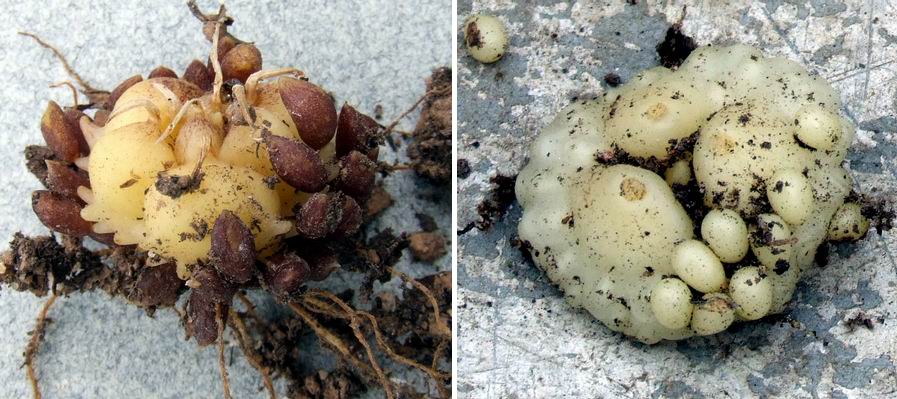
Fritillaria davidii and pudica bulbs
On to another thought I have regarding the Chinese Fritillaria davidii bulb on the left which is similar to the N. American rice grain bulbs like pudica in that the rice grains form on the new bulb in the spring.
In all of the Eurasian rice grain bulbs that we are familiar with, the rice grains form on the old bulb in the autumn. Does this suggest a close family relationship between F davidii and the American frits? Is davidii an ancient relic species that is the link to a common ancestor of all the frits? It will be interesting to observe the bulb growth of some of the other Chinese species that are starting to make their way into our collections.
I have always thought, because of its highly efficient form, that F. pudica was one of the most advanced of the rice grain bulbs in its structure and so was relatively recent in the evolution of fritillaries but its similarity to F. davidii, suggests it may be the other way around and it is an ancient species more closely related to davidii than many others- DNA studies will eventually give us an answer.
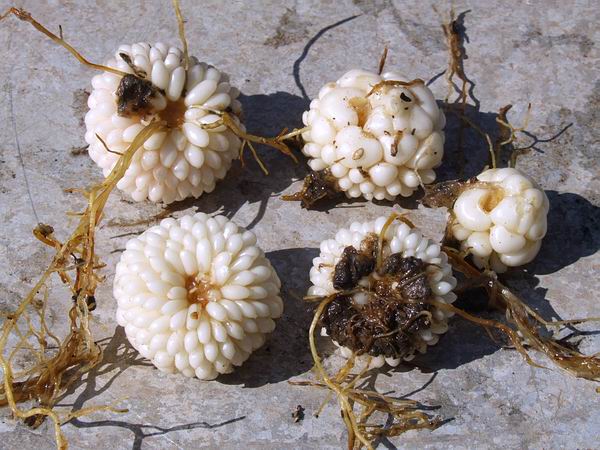
Fritillaria camschatensis Eurasian bulbs
Another link in the evolutionary chain is Fritillaria camschatensis; these are Eurasian bulbs from Siberia. Here we again see a mass of rice grains around the base of the new bulbs - note the dark area attached to the bottom right bulb, this is all that remains of last year's bulb.
Fritillaria camschatensis is the only frit that occurs in both North America and Eurasia and so we can speculate that it is the species or a close relative to the species that pioneered the move from Asia into America: but is it? Could it be that F. camschatensis is coming from North America into Asia? Again we will have to wait for the DNA studies to show the exact relationship between all the bulbs we know as fritillaria and I am convinced there will be some big surprises.
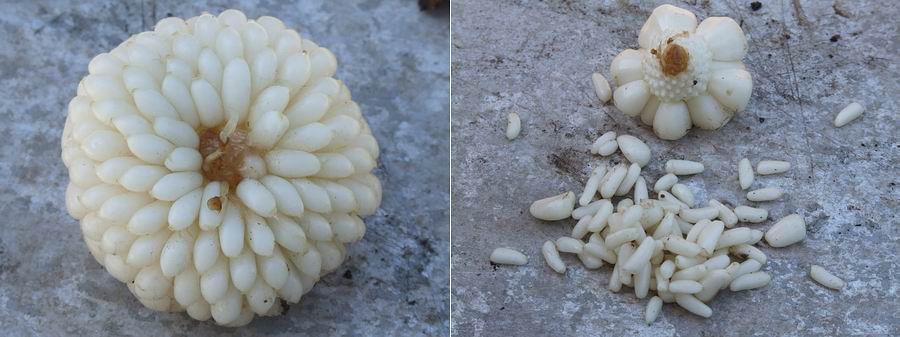
Fritillaria camschatensis bulb with rice
Whatever the relationships are, the bulbs are still wonders of evolution and masters of survival. Here I have removed all the rice grains in the lower part of the bulb. It is more firmly attached than the rice on frits like pudica and affinis but it can still be removed to speed up propagation without harming the parent bulb. If left attached the majority of this rice will not grow on independently, but once they are separated from the adult each grain will form a new bulb that will flower after three or four years.
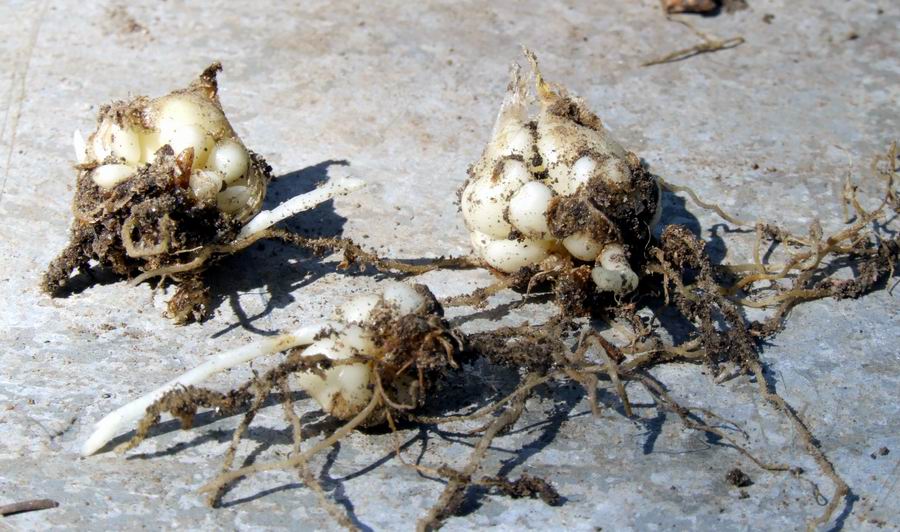
Fritillaria camschatensis bulbs
Other forms of Fritillaria camschatensis have bulbs that exhibit another modification - stolons. Rice grains can only grow on if the parent bulb dies out or if they are moved away from the parent.
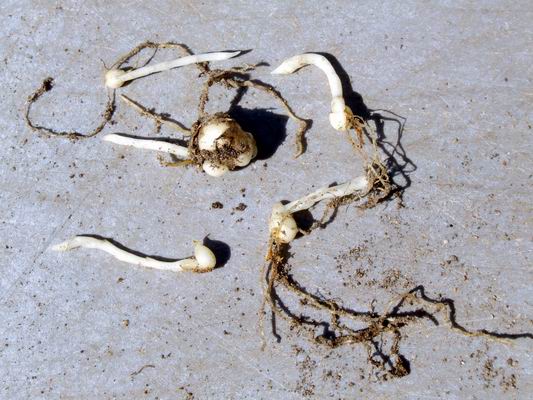
Fritillaria camschatensis stolons
These rice grains form a stolon and by the end of next season they will have formed a small bulbil at a short distance from the parent thereby giving themselves a chance of a life on their own - see how clever and fascinating nature is.
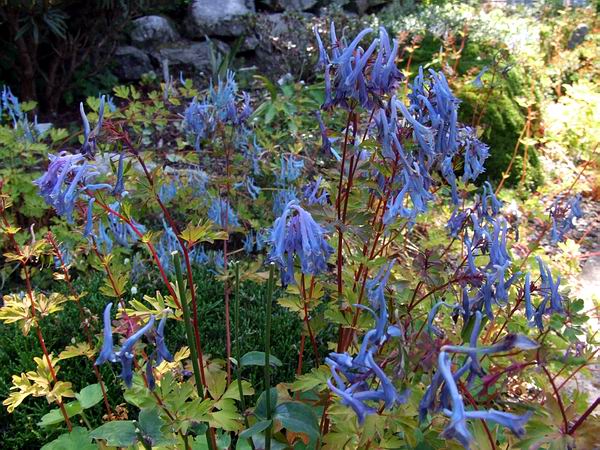
Corydalis x Craigton Blue variant
On to another subject and yes it is Corydalis x Craigton Blue yet again. This is another variant from the cross that has slightly more blue/purple flowers with less white on the lip and it also flowers that wee bit later than the others, extending the season by some weeks.

Corydalis x Craigton Blue and variant
Here I compare typical Corydalis x Craigton Blue on the left and the variant on the right.
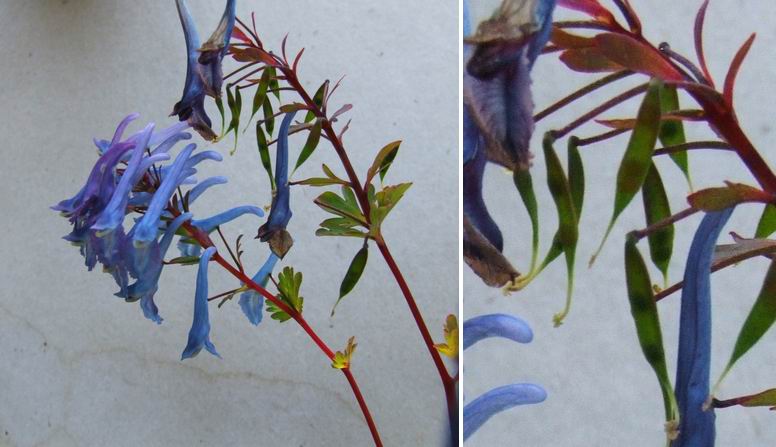
Corydalis x Craigton Blue variant with seeds
The other thing that is noticeable about this variant is that it is setting some seed. I have not noticed any seed pods on normal x Craigton Blue but here you see the variant with several seed pods, not full up but each with just a few seeds in.
^ back to the top ^
|

